October 16: Persian carpet in Oita by Mie
|

|
I visited "Artcraft on Silk Road" exhibition being held here in Oita City. What the most attractive was many Persian carpets. They were so beautiful that I asked to a clerk to get a permission of taking pictures.
|

|
So many tapestries and carpets with brilliant colors and many kinds of materials were displayed on the wall.
|

|
Pictures in the frame? No, they are carpets as well.
|
A special carpet was displayed carefully in a glass case: a fabric woven from 100% silk dotted with gold, corals, turquoises, and other jewels. A 55-year-old female in Harshe Craft center of Isfahan wove the rug in three years (1994-1997), they say. The size of the rug is 102cm×69cm.
|
|
A beautiful lady named Flora Jasmine is from famous Jamshidi in Qom, demonstrating weaving. She learned the technique from her mother at the age of five in 1977, and has been improving her skill of weaving.
|
|
This is a design sheet of the rug, but she seldom refers to it, however. The rug length is about 50 centimeters, taking 10 months to weave. Many colorful silk strings are hanging down from the loom. She quickly picks one of them and weaves into the rug.
|
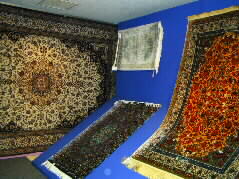
|
So many rugs that remind me of Islamic Mosque are hanging down on the wall. All of them release the scent of Silk Road.
|
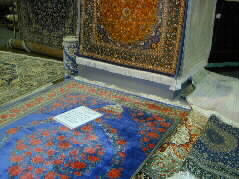
|
Silk rugs produced in Jamshidi studio to which Ms. Jasmine belongs.
|
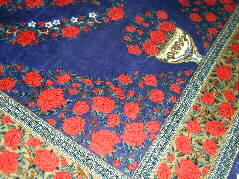
|
Bright red roses are blooming on the background of Persian blue. Click the picture to enlarge.
|
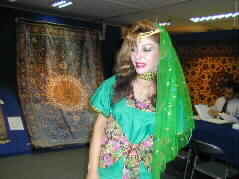
|
Ms. Jasmine came up and explained me, "Rose is the national flower of Iran. Just a quick look is enough to identify that the rug is from Jamshidi studio", she speaks so fluent Japanese. She showed me her magic fingers that weave out wonderful rugs. The long nails were polished in white and gold. Click the picture to enlarge.
|
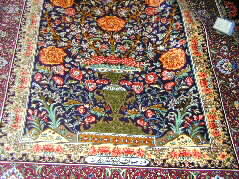
|
Those arts are by Mr. Abolefazl Rajabian, who learned weaving from his father and has handed down the art more than 60 years in his studio. The motif is of rose as well, the national flower of Iran. I wish I could hang such a beautiful colored rug on my wall.
|
|
Quite different designed carpets: they hold very simple taste of Kashugai nomads. They produced such rugs from wool or came fur they keep. They are dyed with vegetables. There are no design sheets, they weave the rug at their inspiration. The camel fur rugs have a pleasant feel. I tried to sniff, hoping I may feel the smell of Silk Road.
The rugs were produced in deserts, transported to Tehran, shipped to Osaka Japan, finally trucked to Oita.
|
|
Rugs with sophisticated design and handed down centuries in the studio in cities or in the palace, or simple rugs handcrafted by normad in the desert without being affected by outside design, they are really impressive respectively. I was very happy to have a chance to see the two different technologies by my naked eyes.
|
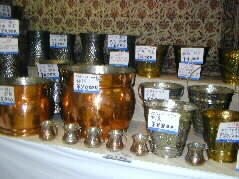
|
Other Silk Road artcraft are also displayed, such as copper vases, accessories, leather goods, clothing, and furniture. I hope I can see them in their native lands.
|













